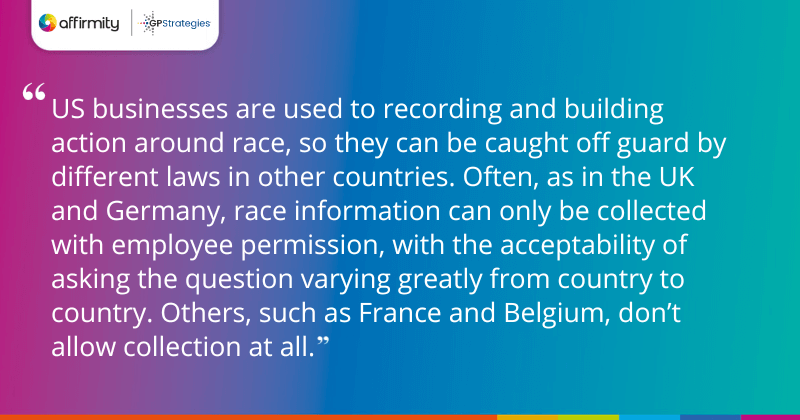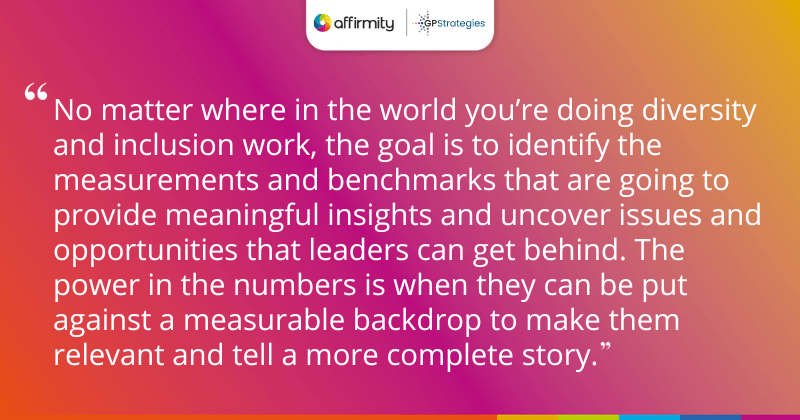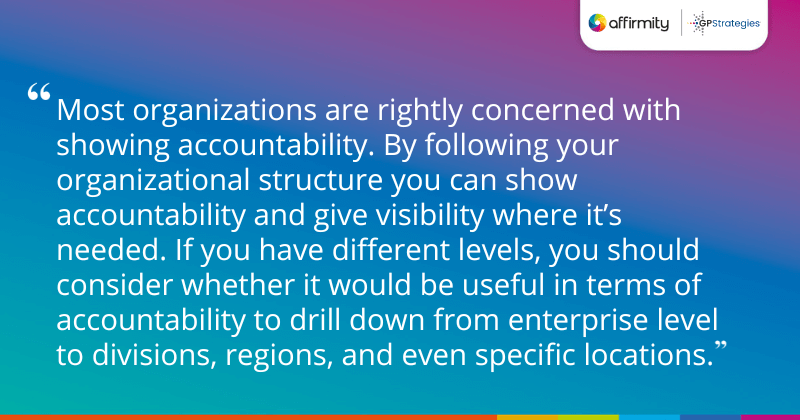It’s well-known that data-driven insights are the key to DE&I success, but data is a complex topic. Knowing what to collect and the context that data should be measured against isn’t so immediately obvious. In this article based on a recent webinar with our team of experts, we look at how companies can best break everything down and compare it to available benchmark data.
What’s the Best Way for Companies to Aggregate or Break Down Their Employee Data?

The starting point in any DE&I plan is to gather data, establish a baseline, and use that to determine if you’re making progress. This is regardless of whether you’re collecting only the narrower demographics used in compliance or you’re branching out into a wider array of characteristics such as LGBTQ+ identities, religion, or any other measurement.
Settling on specific factors or data points is something that requires careful consideration. Failing to ask about certain characteristics may leave you at a disadvantage, but there may also be restrictions on what you can ask that need to be factored in.
We usually recommend breaking things down by organizational structure first. Multinational businesses should do this country by country, but if you have a large presence in any one country (for example, the US) you may need to instead break things down there by segment or region. Secondly, you should break your employee data down by job group. After this, things are less clear-cut. Age (at generational intervals), or salary grades are good options, as is race—but mainly only in the US.
US businesses are used to recording and building action around race, so they can be caught off guard by different laws in other countries. Often, as in the UK and Germany, race information can only be collected with employee permission, with the acceptability of asking the question varying greatly from country to country. Others, such as France and Belgium, don’t allow collection at all. Even when you’re permitted to ask, it’s important to remember that different regions have different lenses on racial and ethnic groupings that a global approach may not capture.
In this way, it’s important to avoid having US-based data when you have global operations. Representation and benchmarking will be very different region to region, so it’s important to capture reliable data through collection and HRIS interfacing that’s sensitive to the needs of each locality.
WHY IS MEASUREMENT IMPORTANT? READ THIS: | ‘Why Workplace Diversity Continues to Stagnate Without Accountability and Measurement’
What Benchmarking Sources Should Businesses Use in the US?
No matter where in the world you’re doing diversity and inclusion work, the goal is to identify the measurements and benchmarks that are going to provide meaningful insights and uncover issues and opportunities that leaders can get behind. The power in the numbers is when they can be put against a measurable backdrop to make them relevant and tell a more complete story.
Nonetheless, many companies will say they have difficulty locating useful benchmarks that help them with assessing their data. Establishing reliable, widely applicable, and realistic benchmarks is key to a successful program. So how should your organization do this? What are some sources of benchmarking data for the US?
- The U.S. Bureau of Labor Statistics has a wealth of tables and information.
- The U.S. Census Bureau is another common source of availability data (2014-2018 data is now widely used).
- Beyond this, data specific to your industry will help you understand how you stack up and help you be realistic about what is achievable.

It’s worth recalling at this point that regulations outside of the US are different, and that these rules often apply to the kinds of data that go-to benchmarking sources collect. Therefore, if you’re a global business, be aware that not all countries capture certain types of information. You’ll have to be creative about what type of benchmarking data you’re using.
Many countries have census bureaus, for example:
- Statistics Canada is the Canadian equivalent.
- France has the Institut National de la Statistique et des Études Économiques (INSEE).
- The UK has the Office for National Statistics (ONS).
- Australia has the Australian Bureau of Statistics (ABS).
- The European Commission adds additional pan-Europe insight on their Eurostat website.
Further sources include:
Note that the previously mentioned U.S. Bureau of Labor Statistics has information on other countries that may be useful to you.
As far as possible, try to stick with a single source. Different terms may have different definitions across certain countries, and even the way the data was collected and then calculated may differ.
MORE DATA CONSIDERATIONS | ‘4 Factors That Will Keep Your Talent Acquisition Data Clean for DE&I’
How Can Companies Use Benchmarking Data to Help Develop DE&I Goals?

As we’re always keen to stress, data is critical to understanding your organizational health and areas for improvement. We know that benchmarking is a critical component of measuring performance. There are many options for benchmarking, but what you benchmark must ultimately be guided by your DE&I goals.
Most organizations are rightly concerned with showing accountability. By following your organizational structure you can show accountability and give visibility where it’s needed. If you have different levels, you should consider whether it would be useful in terms of accountability to drill down from enterprise level to divisions, regions, and even specific locations.
Retailers, for example, may set a goal of having the workforce in each location reflect the make-up of the people they’re serving in their local community. A combination of local benchmarking data and your own internal metrics are needed to provide accountability for that goal.
Alternatively, benchmarking can be highly useful in supporting (or challenging) the gut feelings that leaders have about representation. If a shortfall in people with certain backgrounds is suspected, it’s important to validate the scale of that shortfall, and what is realistic for the business to achieve in that area with benchmark data.
Benchmarking also comes into play when focusing on succession planning and diversifying leadership. Organizations increasingly want their leadership to be reflective of both the environment they work in and the talent available to them. They recognize that changing representation at the top may be a long game, and prepare for it accordingly.
It’s not just about benchmarking to work out who you can attract. When people come into the business, you also want to track their progress and identify areas of stagnant opportunity in your hierarchy that are causing you to fail on representation.
ALSO ON THE BLOG | ‘The Why, How, and What of Good Faith Efforts: Why GFEs Are Important’
Conclusion: Getting Started With Data
These data questions are by no means small. You may need to roll up and visualize hundreds of locations while still being able to meaningfully identify the issues that exist. You ideally need to be additionally layering in some understanding of your intersectional performance too. This means knowing where you stand not only on representation of women and people of color, but women of color, and any other combination of demographics for which you have goals.
As the saying goes, where there’s a will there’s a way. You know what to measure, what to compare it against, and the goals that underpin those metrics. The next step is to build processes and systems that will help you generate the right reports, discussions, and actions.
